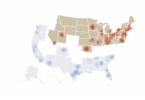Short List
Mother Nature Eases Up

While the news offers little solace for survivors, the occurrence of natural disasters, including flooding, mudslides, wildfires, tornadoes and hurricanes, likely declined overall in 2014 as it did in 2013. The 2014 CoreLogic Natural Hazard Risk Summary and Analysis finds there is a short-term downward trend in the number of individual hazard events in the U.S. that caused more than $1 billion in damage. There were 14 such events in 2011, 11 in 2012 and nine in 2013. The study concludes that this trend likely continued last year, based on the data available when the report was released in late December.
CoreLogic attributes the decline of natural disaster damage in part to the fact that there were no major hurricanes that made landfall in the Gulf of Mexico or on the Atlantic coasts in 2013 or 2014.
Still, several natural disasters wreaked havoc in the U.S. last year, which creates strain on the affected local housing markets and communities. There were major floods in California, Arizona and Michigan, including devastating floods that caused more than $1 billion in damage in metropolitan Detroit.
|
Individual hazard events that caused $1 billion+ in damages in the U.S. |
|
|---|---|
| 2011 | 14 |
| 2012 | 11 |
| 2013 | 9 |
While tornado activity reached its lowest level in recent years in 2014, a powerful tornado that hit Arkansas last spring destroyed more than 400 homes and claimed 16 lives. The most damaging 2014 wildfire, meanwhile, was the Carlton Complex fire, which destroyed more than 300 homes in the state of Washington.
CoreLogics report says its impossible to predict the impact of natural disasters in 2015, but concludes its likely the U.S. will experience a return to higher numbers and more damaging events.
Find the entire report at CoreLogic’s website.







